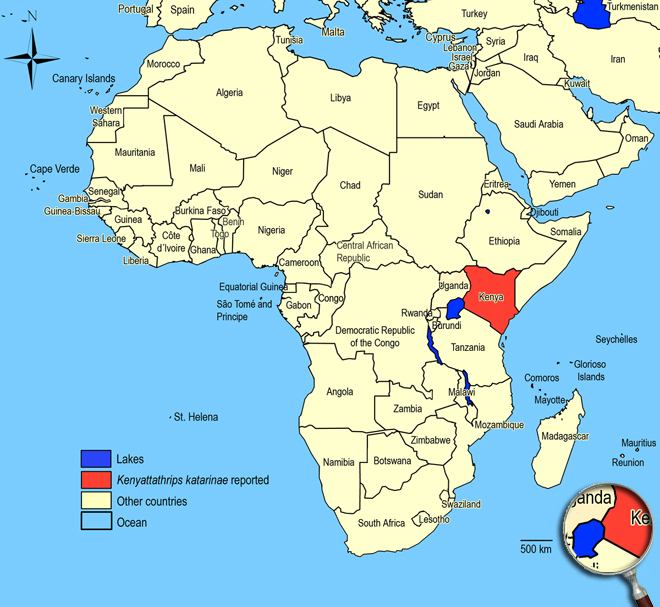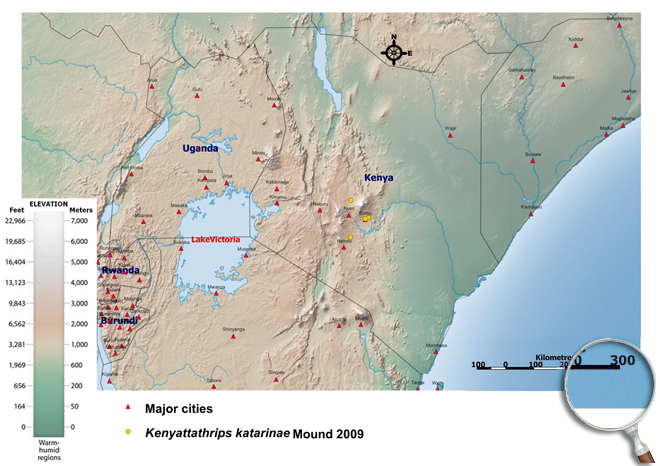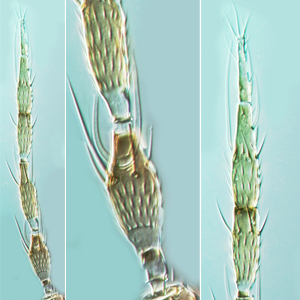Kenyattathrips katarinae Mound, 2009
Thripinae, Thripidae, Terebrantia, Thysanoptera
Figures
Fig. 1: Antennal segments III-VII, segments III and IV with forked sense cone, terminal segments V-VII
Fig. 2: Head dorsal with ocellar triangle, scape and pedicel of antennae
Fig. 3: Pronotum
Fig. 4: Meso- and metanotum
Fig. 5: Fore wing basal region, clavus
Fig. 6: Fore wing and fore wing distal region
Fig. 7: Tergites II and III
Fig. 8: Tergites IV and V, lateral region
Fig. 9: Tergites VII and VIII with posteromarginal comb
Fig. 10: Tergites VIII and IX
Introduction and recognition
Kenyattathrips katarinae are found on leaves of khat (Catha edulis). Both sexes fully winged. Body bicolored; antennae mainly brown, segments III & IV yellow at base; head yellow medially, brown on anterior margin and posterolaterally; pronotal lateral thirds brown, yellow medially; meso- and metanotum with light brown markings laterally; legs yellow; tergites II-VIII brown medially but yellow laterally, tergal lateral setae dark, also terminal setae of abdomen; fore wings brown, paler toward apex, and with dark setae. Antennae 7-segmented; segments III & IV with long forked sense cone and apical neck, segment II with inner dorsal apical seta very long (Fig. 1). Head broad across and prolonged in front of compound eyes; vertex closely striate; 3 pairs of ocellar setae, pair I longer than pair III and arising far forward on broad inter-antennal projection, pair III small and arising on anterior margins of ocellar triangle (Fig. 2). Pronotum with closely spaced transverse sculpture lines; posterior margin with 4 pairs of setae, pair I arising sub-marginally, II and III very long and equal in length, IV minute; 1 pair of very long setae anteromarginally and 1 pair moderately long laterally (Fig. 3). Meso- and metafurca with spinula. Metanotum weakly reticulate medially; median setae arise behind margin; campaniform sensilla absent (Fig. 4). Mid and hind tarsi 2-segmented. Fore wing first vein with about 5 basal and 2 distal setae; second vein with a complete row of 7-8 setae; clavus with 3 veinal setae; posteromarginal cilia wavy (Fig. 5 and 6). Tergites II-VI with median setae small but close together (Fig. 7), VII & VIII with median setae longer and further apart, all with median setal pair longer than distance between their bases; II-VIII with lateral thirds covered with regular, closely spaced rows of fine microtrichia (Fig. 8); posterior margins of VII & VIII with complete comb of irregular and short microtrichia (Fig. 9); IX with many microtrichia on posterior half (Fig. 10). Sternites transversely reticulate and without microtrichia; posteromarginal setae on sternite VII arise in front of margin.
Male similar to female in structure and color, but smaller and abdomen paler; abdomen without drepanae on tergite IX, and without glandular areas.
Second instar larva: Surface of abdomen and thorax, but including only median area of pronotum, finely granulate, remainder of pronotum smooth; on tergite IX the granulation grades into sharply pointed microtrichia at posterior; major setae capitate; head unusually broad.
Taxonomic identity
Species
Kenyattathrips katarinae Mound, 2009
Taxonomic history
-
Common name
-
Present taxonomic position
Family: Thripidae Stephens, 1829
Subfamily: Thripinae (Stephens) Karny, 1921
Genus: Kenyattathrips Mound, 2009
Genus description
The genus Kenyattathrips Mound, 2009
There is only 1 species known in this genus, Kenyattathrips katarinae, from East Africa. It is a member of the Scirtothrips genus-group with most of character states of this genus, but the pronotum bears 2 pairs of long posteromarginal setae, 1 pair laterally, and 1 pair of long anteromarginal setae, and the fore wing second vein has an almost continuous row of setae. Furthermore, Kenyattathrips has 7-segmented antennae with forked sense cone on segments III & IV, exceptionally long seta at the inner apex of the antennal segment II, long ocellar setae pair I placed far forward on the inter-antennal projection and a complete posteromarginal comb on tergites VII and VIII (Mound 2009).
Species description
Typical key character states of Kenyattathrips katarinae
Coloration and body sculpture
Body color: distinctively bicolored
Surface of head, pronotum and fore legs: without obvious or with weakly reticulate sculpture
Antennae
Form of sense cones on antennal segments III and IV: emergent and forked on segments III and IV
Number of antennal segments: 7
Antennal segment I: without any setae on dorsal apical margin
Antennal segment II: with an exceptionally long seta at the inner apex
Antennal segment II shape: symmetric
Antennal segment III shape: symmetric
Length of antennal segment III and IV: antennal segment III similar in length to segment IV
Forked sense cone on antennal segment IV: extending to a point at least a third to base of segment V
Antennal segment IV and V: without a hyaline ring near the base
Antennal segment VI bears: not a remarkably dagger-shaped sensorium
Head
Distance between bases of ocellar setae III: greater than width of first ocellus
Head: distinctly prolonged in front of compound eyes
Ocellar setae I: present
Length of ocellar setae I: longer than setae III
Length of ocellar setae II: shorter than setae III
Ocellar setae III: arising on anterior margin of, or in front of ocellar triangle
Ocelli: present
Length of postocular setae: not alternating short and long setae
Ocellar setae I position: long and arising far forward on inter-antennal projection
Number of ocellar setae: 3
Prothorax
Number of pairs of long anteroangular setae: 0-1
Number of pairs of long posteroangular setae: 0-1
Number of pairs of elongate pronotal setae: 3-4
Pronotal blotch or internal apodeme: absent
Pronotum shape: broadly rectangular
Pronotum surface: with transverse striate sculpture
Pronotum posteromarginal/posteroangular setae: S2 and S3 long, equal in length
Mesothorax
Mesosternal furca: with median spinula
Metathorax
Metanotal campaniform sensilla: absent
Metanotal median setae: S1 behind anterior margin
Metanotum with dominant sculptured triangle medially: absent
Metasternal furca: with spinula
Shape of metathoracic furca: transverse, V-shaped
Wings
Fore and hind wings: present, more than half as long as abdomen (macropterous)
Fringe cilia arising: from sockets
Fore wing veins: present
Fore- and hind wing surface: covered with microtrichia
Apex of fore wing: with prominent terminal setae
Fore wing anterior margin (costal vein): with setae and cilia but cilia longer than setae
Fore wing costal fringe cilia: arising at anterior margin of wing
Fore wing first vein: distinct from costal vein
Fore wing first vein setal row: incomplete, with setae not closely and uniformly spaced
Fore wing second vein setal row: complete, setae uniformly spaced
Fore wing shape: mainly parallel sided or margins run continuously towards each other
Fore wing surface: not reticulate
Fringe cilia on posterior margin near apex: distinctly wavy (undulated)
Length of fore wing costal setae at middle of wing: longer than half of median wing width
Shape of fore wing apex: with mainly posterior margin curved to join anterior margin
Fore wing extreme apex color: pale
Fore wings: uniformly light brown (rare: uniformly pale or weakly shaded)
Legs
Fore tibia: not prolonged around fore tarsus
Mid and hind tarsi: with two segments
Color of fore tarsi: pale or yellow, sometimes apical shaded or brown
Abdomen
Pleurotergites: not covered in microtrichia
Sternite II: with marginal setae but no discal setae
Sternites IV, V and VI: with marginal setae but no discal setae
Sternite VII median posteromarginal setae S1: arising in front of posterior margin
Sternite VII: with marginal setae but no discal setae
Surface of lateral thirds of abdominal tergites: with many regular rows of fine microtrichia
Craspedum on tergites IV to VI: absent
Markings on tergites IV to VI: with shaded areas medially
Tergites IV and V median setal pair: longer than distance between their bases
Tergites V to VII: without ctenidia laterally, but sometimes with rows of microtrichia
Craspedum on tergite VIII: without craspedum medially and toothlike microtrichia laterally
Tergite VIII ctenidia: without paired ctenidia laterally, sometimes with irregular microtrichia
Tergite VIII posteromarginal comb of microtrichia: present and complete medially
Tergite VIII shape of posteromarginal microtrichia: short and irregular in length
Tergite IX microtrichia medially: present
Tergite X: not tubular, longitudinally incomplete
Setae on abdominal tergite X: all setae slender

Similar or related species
Kenyattathrips katarinae is related to species of the genus Scirtothrips. All of them having regular, closely spaced rows of fine microtrichia on the lateral sides of the tergites and a complete comb on tergite VIII, antennal segments III & IV with forked sense cones, and the pronotum on these thrips is closely and transversely striate. Compared to Kenyattathrips katarinae, all species of Scirtothrips have 8-segmented antennae, antennal segment II without an exeptionally long seta at the inner apex, ocellar setal pair I short and behind base of scape and in front of anterior ocellus, only 1-2 pairs of elongate pronotal setae and no long anteromarginal setae on the pronotum, metanotum reticulated medially, fore wing second vein with a few apical setae, and tergite VII with a posteromarginal comb of microtrichia only laterally. Whereas Kenyattathrips katarinae has 7-segmented antennae, antennal segment II with an exceptionally long seta at the inner apex, a long ocellar setal pair I placed far forward on the inter-antennal projection, 3-4 pairs of elongate pronotal setae (1 pair anteromarginally, 1 pair moderately elongate laterally, 2 pairs posteromarginally), a metanotum without or with weakly sculpture medially, an almost complete row of setae on fore wing second vein, and a complete posteromarginal comb of microtrichia on tergite VII.
Furthermore Kenyattathrips katarinae is similar to Neohydatothrips samayunkur and Hydatothrips adolfifriderici in having the surface of lateral thirds of tergites with many regular rows of fine microtrichia. But Neohydatothrips samayunkur and Hydatothrips adolfifriderici have fore wings with a complete row of setae on the first vein and without or with 2 setae on the second vein, and a distinctive colored and/or sculptured area on the pronotum, the pronotal blotch.
Biology
Life history
As with other thrips species the life cycle from egg to adult is dependent on temperature. The full cycle can take about 15 days (Lewis 1973) to over a month and adults may live for more than one month producing several generations in one year depending on seasonal weather.
Host plants
Khat (Catha edulis).
Vector capacity
None identified, but possible mechanical distribution of phytopathogenic fungi and bacteria.
Damage and symptoms
-
Detection and control strategies
-
Additional notes
-
Biogeography
East Africa. Kenya.
African countries where Kenyattathrips katarinae has been reported

Occurence of Kenyattathrips katarinae in East Africa

Please click here for survey sites of all observed thrips species of Kenya, Tanzania and Uganda.
Click here for locations of Kenyattathrips katarinae in parts of East Africa.

Bibliography
Lewis T (1973). Thrips: their biology, ecology and economic importance. Academic Press Inc., London Ltd., 349 pp
Mound LA (2009). A new genus and species of Scirtothrips genus-group (Thysanoptera: Thripidae) from Kenya, intercepted by Australian quarantine. Zootaxa. 2210: 65-68
----
Web links
Mound´s Thysanoptera pages
Thysanoptera Checklist
ICIPE Thrips survey sites
UNI Halle & Thrips sites
Thrips of California














